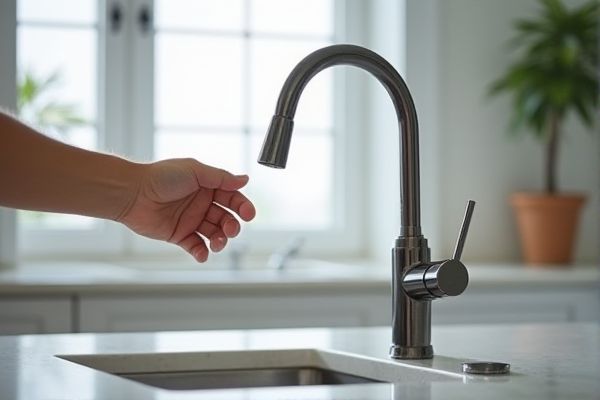
A touchless faucet uses motion sensors to activate water flow without physical contact, promoting hygiene and reducing germ transfer, while a touch-activated faucet requires a simple touch to the spout or handle to start water flow, offering convenience and precise control. Discover which faucet type best suits Your kitchen or bathroom needs by exploring the detailed comparisons in this article.
Table of Comparison
| Feature | Touchless Faucet | Touch-Activated Faucet |
|---|---|---|
| Activation Method | Infrared sensor detects hand movement | Physical touch or tap on the faucet surface |
| Hygiene | High - no contact required, reduces germ spread | Moderate - still requires contact, some germ transfer |
| Water Efficiency | Automatically shuts off; reduces water waste | Manual control; depends on user to turn off |
| Power Source | Batteries or hardwired | Batteries or hardwired |
| Installation Complexity | Typically higher due to sensors and wiring | Moderate, similar to traditional faucets |
| Maintenance | Sensor cleaning and occasional battery replacement | Less sensor maintenance, battery replacement only |
| Cost | Higher upfront cost | Generally lower cost than touchless models |
| Ideal Use Case | Public restrooms and hygiene-focused environments | Residential kitchens and bathrooms |
Introduction to Touchless and Touch-Activated Faucets
Touchless faucets use infrared sensors to detect hand movements, enabling water flow without physical contact, while touch-activated faucets require a simple tap on the faucet body to start or stop water flow. Both technologies enhance hygiene by minimizing surface contact, with touchless faucets often preferred in public spaces for maximizing germ prevention. Touch-activated faucets offer a balance between convenience and control, making them ideal for residential kitchens and bathrooms where tactile feedback is desired.
How Touchless Faucets Work
Touchless faucets operate using infrared sensors that detect the presence of your hands, triggering the valve to release water without physical contact. This sensor technology helps prevent the spread of germs and conserves water by automatically shutting off when hands are removed from the detection zone. Your kitchen or bathroom can benefit from the hygiene and efficiency provided by these hands-free fixtures.
How Touch-Activated Faucets Operate
Touch-activated faucets operate by detecting the electrical conductivity of your skin, allowing you to turn the water flow on or off with a simple touch on the spout or handle. These faucets use capacitive touch sensors that send signals to a control module, activating the solenoid valve to control water flow instantly. Your hands must make direct contact with the sensor, differentiating them from touchless faucets that rely on infrared motion detection.
Key Differences Between Touchless and Touch-Activated Faucets
Touchless faucets use infrared sensors to detect hand movements, enabling water flow without physical contact, ensuring enhanced hygiene and reducing germ transmission. Touch-activated faucets require a simple tap or touch on the faucet body to start or stop water flow, offering convenience while still maintaining some physical interaction. Both types improve water efficiency, but touchless faucets generally provide a more sanitary option suitable for high-traffic areas.
Hygiene and Germ Prevention: Which Is Better?
Touchless faucets use infrared sensors to detect hand presence, minimizing surface contact and significantly reducing the risk of germ transfer, making them superior for hygiene and germ prevention. Touch-activated faucets require physical contact to operate, which increases the chance of spreading bacteria and viruses on frequently touched surfaces. In environments prioritizing cleanliness such as hospitals and kitchens, touchless faucets consistently offer better protection against cross-contamination.
Water Efficiency and Conservation
Touchless faucets utilize infrared sensors to control water flow, significantly reducing water waste by automatically shutting off when hands are removed, promoting optimal water efficiency. Touch-activated faucets require physical contact but still conserve water through timed shutoff features, although they may inadvertently remain on longer due to delayed user interaction. Both technologies improve water conservation compared to traditional faucets, but touchless models offer superior efficiency by eliminating the risk of user error in water usage.
Installation and Setup Requirements
Touchless faucets typically require a power source, either batteries or an electrical connection, and may involve more complex installation due to sensor placement and wiring. Touch-activated faucets generally have simpler installation processes similar to traditional faucets, often needing only a connection to the water supply without additional electrical components. Choosing between the two depends on the ease of setup desired and the availability of power sources in the installation area.
Maintenance and Durability Comparison
Touchless faucets typically require less maintenance due to their sealed sensor technology, which reduces wear and tear from frequent physical contact, increasing their durability and lifespan. Touch-activated faucets involve mechanical components that may wear out over time, requiring more frequent cleaning and repairs to maintain sensor sensitivity and functionality. Studies show touchless models can have up to 30% longer operational durability compared to touch-activated faucets, making them more cost-effective in the long run.
Cost and Energy Considerations
Touchless faucets generally incur higher initial costs due to advanced sensors and technology integration, while touch-activated faucets tend to be more affordable and simpler to install. Touchless models often require batteries or electricity, leading to ongoing energy expenses, whereas touch-activated faucets typically operate mechanically without additional power consumption. Evaluating long-term energy use and maintenance requirements is essential for cost-effective kitchen or bathroom faucet selection.
Choosing the Right Faucet for Your Home
Touchless faucets use infrared sensors to detect hand motion, offering a hygienic, hands-free experience that reduces water waste and prevents cross-contamination. Touch-activated faucets require a simple touch on the spout or handle, combining convenience with manual control, making them ideal for users who want quick activation without sensor reliance. Selecting the right faucet depends on your household's hygiene priorities, ease of use preferences, and maintenance considerations, ensuring optimal functionality and water efficiency.
 homyna.com
homyna.com